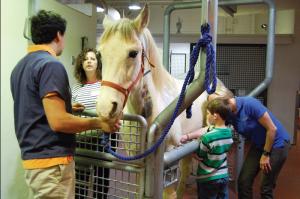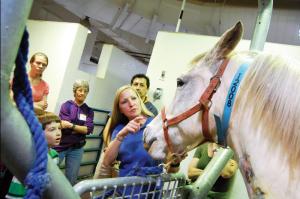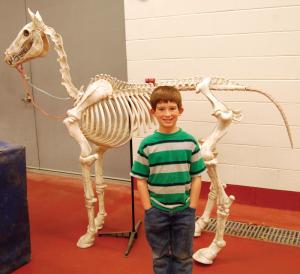By Ethan T. Lail (age 9,) with some assistance from mother Allison Brannon Lail; photos by Allison Lail
On Saturday March 30, 2019 my mom and I walked into the UT Vet Hospital in Knoxville, Tenn. to attend one of the sessions at the Horse Owners Seminar – listening, observing, and learning how to perform a basic physical exam on a horse, presented by Dr. Meggan Graves, graduate of the University of Tennessee School of Veterinary Medicine. Just like I attend a yearly check up at the doctor, we, too, check the basics on our horse(s). Let’s get started!
First you want to take a good look at your horse. Look for symmetry; same on both sides over the whole body. Check their eyes. Are they goopy, runny, or with spots? Check their nose for discharge; check teeth, mouth, gums, color. Mucus Membrane: press down on their gums, wait 2 seconds, lift up. If it’s not pink, there is something wrong. Run your hand under the jaw, checking lymph nodes. If they are puffy, abnormal, or swollen, something is wrong. If the same, they’re fine.
As you are grooming or daily checking when feeding, check for abnormal breathing, standing sloppily, sad, depressed, or even the opposite – happy and alert. Check their legs, joints, knees, hocks, fetlock, and feet. Check for puffiness, swelling, and – very important – digital pulse.
What is a digital pulse? It’s like your heart beat in your feet! The digital pulse can be felt on the lower leg of your horse in the fetlock and pastern area.
Gut sounds! Usually you can hear normal gut sounds just standing next to the horse. You can also use the stethoscope to listen. Located up high near the hip are the colon and cecum. Down low are the small intestines. What does it sound like? Does it sound like gurgles, like water running through a pipe, rumble tumble, or even no sounds? No sounds? Call the vet!
Now for TPR. What is that?
1.Temperature. Check with a basic thermometer inserted in the anus. Yup, in the butt! Core temperature. Make sure to always have a hand on the horse to let them know you are there. Don’t want to startle them! Temperature should range 98-101 degrees Fahrenheit.
2.Pulse. Use your stethoscope to listen to the heart on left side of horse just behind the elbow at the girth area. Listen for 15 seconds, times that by four. Remember ear pieces face forward. Now you will check every doctor show you see on TV. Normal heart rate is 24-48 beats per minute, average 36 beats per minute. Don’t have a stethoscope? On the left side of the horse use your right hand, first two fingers behind the jawline to feel the pulse.
3.Respiration. Breathing. What happens if you put your hand up to the horse’s nose? Yes, do you think you will get an accurate count? Nope. You can stand about a foot away and watch their sides move in and out. Count for 15 seconds and times that by four. Normal respiration rate is 8-24 breaths per minute.
Here’s a list of questions you might ask your veterinarian.
1.How big is horse’s heart? About a size 3 soccer ball. Did you know that Secretariat had heart three times larger than average?
2.What is a heart murmur? This is a hole in one of the valves in the horse’s heart. Through a stethoscope, you will hear the blood rushing through the heart with sounds like “lub dub shhh, or lubshhh dub,” depending on where that hole is located.
3.How big are the horse’s lungs? Each one is the size as big as my little brother! He’s 4 years old. Where are the lungs? Draw a line from elbow to the point of the hip. Everything above that are lungs. This is why horses are big runners!
4.How big or long are horse’s intestines? 100 feet. That’s like 4 school buses! As big as four of my dad’s gooseneck rollback trailer!
5.How big is the stomach? The size of a rugby ball or my piggy bank. This explains why horses graze all day and can’t take big single meals.
6.What are core items to have in your first aid kit? Something to clean a wound, something to stop bleeding, a wrap such as baby diaper and bandage wrap, duct tape, stethoscope, thermometer, pen and paper to write down veterinary number, and TPR information.
Those are most of the things you need for full basic physical exam on a horse.
At the end of the exam, we as a group got to tour the veterinary hospital. We saw a few horses recovering from injury, two baby foals with their mamas, doing better than when they first arrived.
We could see through a window a horse in ICU/ISO (isolation). We do not enter; only vet techs and veterinarians are allowed through its own entrance, plus it has its own heat and air system. Those horses in ISO usually have diarrhea, high temperature, or high white blood count; very sick.
Then we walked through the ruminant and cow side of the hospital, with a rotating stock to easily trim cow’s hooves!
I then saw the skeleton of a horse in another room, where another session of the seminar was taking place: about chiropractic medicine on a horse.
I think the seminar was pretty interesting and cool, and the hospital was pretty awesome! I might just come to school here one day. I don’t get to see or be around horses very often; only on hay deliveries and when I visit my grandparents.
On Saturday March 30, 2019 my mom and I walked into the UT Vet Hospital in Knoxville, Tenn. to attend one of the sessions at the Horse Owners Seminar – listening, observing, and learning how to perform a basic physical exam on a horse, presented by Dr. Meggan Graves, graduate of the University of Tennessee School of Veterinary Medicine. Just like I attend a yearly check up at the doctor, we, too, check the basics on our horse(s). Let’s get started!
First you want to take a good look at your horse. Look for symmetry; same on both sides over the whole body. Check their eyes. Are they goopy, runny, or with spots? Check their nose for discharge; check teeth, mouth, gums, color. Mucus Membrane: press down on their gums, wait 2 seconds, lift up. If it’s not pink, there is something wrong. Run your hand under the jaw, checking lymph nodes. If they are puffy, abnormal, or swollen, something is wrong. If the same, they’re fine.
As you are grooming or daily checking when feeding, check for abnormal breathing, standing sloppily, sad, depressed, or even the opposite – happy and alert. Check their legs, joints, knees, hocks, fetlock, and feet. Check for puffiness, swelling, and – very important – digital pulse.
What is a digital pulse? It’s like your heart beat in your feet! The digital pulse can be felt on the lower leg of your horse in the fetlock and pastern area.
Gut sounds! Usually you can hear normal gut sounds just standing next to the horse. You can also use the stethoscope to listen. Located up high near the hip are the colon and cecum. Down low are the small intestines. What does it sound like? Does it sound like gurgles, like water running through a pipe, rumble tumble, or even no sounds? No sounds? Call the vet!
Now for TPR. What is that?
1.Temperature. Check with a basic thermometer inserted in the anus. Yup, in the butt! Core temperature. Make sure to always have a hand on the horse to let them know you are there. Don’t want to startle them! Temperature should range 98-101 degrees Fahrenheit.
2.Pulse. Use your stethoscope to listen to the heart on left side of horse just behind the elbow at the girth area. Listen for 15 seconds, times that by four. Remember ear pieces face forward. Now you will check every doctor show you see on TV. Normal heart rate is 24-48 beats per minute, average 36 beats per minute. Don’t have a stethoscope? On the left side of the horse use your right hand, first two fingers behind the jawline to feel the pulse.
3.Respiration. Breathing. What happens if you put your hand up to the horse’s nose? Yes, do you think you will get an accurate count? Nope. You can stand about a foot away and watch their sides move in and out. Count for 15 seconds and times that by four. Normal respiration rate is 8-24 breaths per minute.
Here’s a list of questions you might ask your veterinarian.
1.How big is horse’s heart? About a size 3 soccer ball. Did you know that Secretariat had heart three times larger than average?
2.What is a heart murmur? This is a hole in one of the valves in the horse’s heart. Through a stethoscope, you will hear the blood rushing through the heart with sounds like “lub dub shhh, or lubshhh dub,” depending on where that hole is located.
3.How big are the horse’s lungs? Each one is the size as big as my little brother! He’s 4 years old. Where are the lungs? Draw a line from elbow to the point of the hip. Everything above that are lungs. This is why horses are big runners!
4.How big or long are horse’s intestines? 100 feet. That’s like 4 school buses! As big as four of my dad’s gooseneck rollback trailer!
5.How big is the stomach? The size of a rugby ball or my piggy bank. This explains why horses graze all day and can’t take big single meals.
6.What are core items to have in your first aid kit? Something to clean a wound, something to stop bleeding, a wrap such as baby diaper and bandage wrap, duct tape, stethoscope, thermometer, pen and paper to write down veterinary number, and TPR information.
Those are most of the things you need for full basic physical exam on a horse.
At the end of the exam, we as a group got to tour the veterinary hospital. We saw a few horses recovering from injury, two baby foals with their mamas, doing better than when they first arrived.
We could see through a window a horse in ICU/ISO (isolation). We do not enter; only vet techs and veterinarians are allowed through its own entrance, plus it has its own heat and air system. Those horses in ISO usually have diarrhea, high temperature, or high white blood count; very sick.
Then we walked through the ruminant and cow side of the hospital, with a rotating stock to easily trim cow’s hooves!
I then saw the skeleton of a horse in another room, where another session of the seminar was taking place: about chiropractic medicine on a horse.
I think the seminar was pretty interesting and cool, and the hospital was pretty awesome! I might just come to school here one day. I don’t get to see or be around horses very often; only on hay deliveries and when I visit my grandparents.









